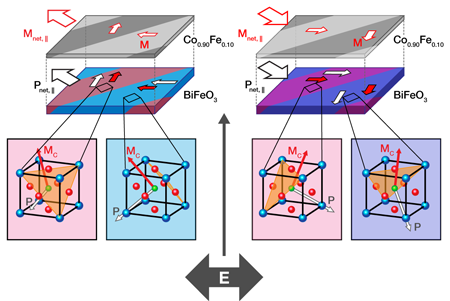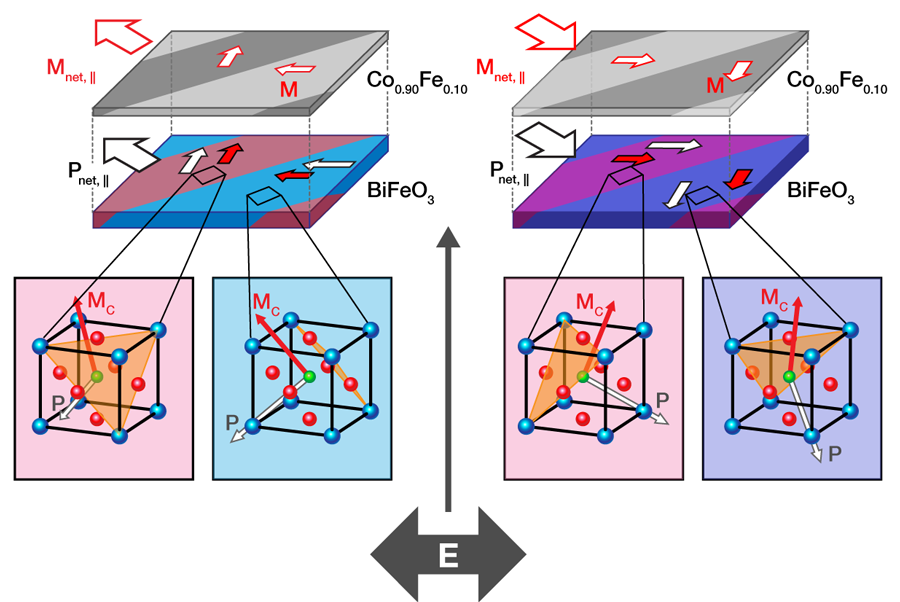Zigzag Polarization Straightens Magnetization Out
Materials displaying ferromagnetism (long range magnetic order) or ferroelectricity (long range electric order) are omnipresent in our daily life. Ferromagnetism is key to devices like power transformers or computer hard disks, while ferroelectricity is the basis of actuators, sensors, capacitors, and nonvolatile computer memory. A single compound that boasts both properties—a so-called multiferroic—could be the basis of a host of new applications, particularly if electric order can control magnetic order (and vice versa).
Now, John Heron at the University of California, Berkeley, and colleagues have achieved one of the long-standing goals of multiferroics research: they show they can reversibly switch the magnetization of a multiferroic system by 180° with the application of an electric voltage at room temperature. The results, appearing in Physical Review Letters [1], could pave the way to a new generation of compact magnetic devices with unmatched energy efficiency.
As early as 1894, Pierre Curie suggested that magnetoelectricity—the interaction between dielectric and magnetic properties—offered a way to change a material’s magnetic properties with an electric field. Half a century later, magnetoelectricity was discovered in Cr2O3, but it was far too small and too rarely occurring in other materials to be of any technological use.
Hope resurged when, many years after their actual discovery, multiferroics were recognized as a potential source for pronounced magnetoelectric effects (for a review see Ref. [2]). Yet the marriage between magnetic and electric order is not, it turns out, a happy one. The most prominent mechanisms promoting magnetic order exclude electric order (and likewise the other way around) so multiferroicity is always a compromise [3]. It usually occurs only at low temperature and the magnetization or the polarization (or both) are orders of magnitude smaller than in established ferromagnets and ferroelectrics. This also holds for BiFeO3, the only compound so far displaying robust multiferroicity under ambient conditions. Bulk BiFeO3 is ferroelectric and antiferromagnetic; but in thin-film form the antiferromagnetic order is supplemented by a small net magnetization. The ferroelectric order has eight different domain states and is thus quite complex. Nevertheless, about a third of all multiferroics research is now devoted to BiFeO3 and its derivatives, which has indeed led to remarkable advances.
Since naturally occurring magnetoelectric multiferroics are so rare, many researchers have pursued the strategy of making composite materials that are mixtures of ferromagnets and ferroelectrics interacting magnetoelectrically via strain. A magnetic field applied to the magnetostrictive component induces strain, which, when transmitted to the piezoelectric component, induces an electric polarization. In spite of the relatively crude nature of this type of method, it has, within limits, been very effective: A magnetoelectric response exceeding that found in Cr2O3 by orders of magnitude was obtained at microwave frequencies [2]. For instance, persistent and large magnetoelectric effects are achieved when CoFe2O4 nanorods are grown in a self-organized way within a BiFeO3 matrix. An electric field can stimulate a partial reversal of the nanorods’ magnetization [4], but the strain-mediated coupling tends to be unreliable and only partly effective because of unexplored imperfections at the interface between the nanorods and the matrix.
With striking improvements in the growth of thin oxide films and heterostructures, more refined approaches have became possible. Even if multiferroics do not exhibit a pronounced magnetization per se, their magnetoelectric properties may be an effective mediator for coupling an applied electric field to the magnetization of, say, an alloy deposited on top of it. For this approach, the fact that BiFeO3 is a room-temperature multiferroic makes it the preferred candidate material in such a heterostructure. However, several notable developments and discoveries were necessary to make practical devices out of BiFeO3. First, researchers learned how to grow well-defined patterns of the eight different ferroelectric domains in BiFeO3, which simplifies the investigation and control of the correlation between magnetic and ferroelectric order [5]. Second, a group in France discovered a coupling between the antiferromagnetic order in BiFeO3 and the axis along which the spontaneous electric polarization is oriented [6]. Finally, the Berkeley group found that when they deposited Co0.90Fe0.10, a ferromagnetic alloy, onto films of BiFeO3, the magnetization of the alloy was strongly “pinned” to the antiferromagnetic order in the BiFeO3 [7]. In such a device, this group showed that reversing the direction of an applied magnetic field could rotate the magnetization axis of the alloy by 90° [7].
In their present paper, the Berkeley group continues this line of work and demonstrates reversible voltage-induced 180° switching of CoFe magnetization via polarization control in a BiFeO3 film. This is much more than replacing one type of magnetoelectric rotation by another. In the earlier experiment, the magnetoelectric switching was not deterministic because even when the axis of the CoFe magnetization rotated by 90°, the direction of the magnetization along this axis remained ambiguous. Heron et al. have established a unique relation between polarization and magnetization with respect to a given axis. The polarization of each domain in the BiFeO3 film is coupled to its magnetization (see Fig. 1). The magnetization of BiFeO3 uniquely determines the magnetization of CoFe.
Further, it is essential that arrangements of BiFeO3 domains, rather than individual domains, determine the switching process. Stripes with two different types of domain states constitute this pattern—its growth is a particular challenge. The 180° switching process occurs in two steps. The applied voltage triggers the polarization rotation in one of the domain states. As a consequence, domain walls with an unfavorable head-to-head meeting of opposite polarizations form. This triggers the second polarization rotation in the remaining domain state. In total, the projection of the net polarization of the domain pattern reverses its sign and with it the projection of the net magnetization of the BiFeO3 and the CoFe.
Heron et al. performed simulations to verify the correctness of the proposed switching scenario, which advances the work beyond mere phenomenology. This type of theoretical framework may be a useful guide on how to vary the design of these devices and improve their efficiency.
Heron et al.’s results constitute a milestone in the development of magnetoelectric devices that can be built and operated under technologically feasible conditions. Voltages can be generated with much smaller currents than magnetic fields, so devices with voltage-controlled magnetization waste less heat and can be made more compact. Heron et al.’s work also demonstrates that adding structural functionality as a design concept can enhance magnetoelectric effects in multiferroics. Alternative approaches along the same lines could take advantage of magnetoelectric interface states, magnetoelectric superlattices, or magnetic metamaterials.
Although voltage control of magnetization is the declared goal of multiferroics research, the time evolution of the magnetoelectric reversal process is an important, though rarely discussed, consideration [8]. Fast magnetoelectric switching is essential for memory applications, so it will be interesting to investigate the time-dependence of the voltage-induced magnetization switching introduced by Heron et al.
References
- J. T. Heron, M. Trassin, K. Ashraf, M. Gajek, Q. He, S. Y. Yang, D. E. Nikonov, Y-H. Chu, S. Salahuddin, and R. Ramesh, Phys. Rev. Lett. 107, 217202 (2011)
- M. Fiebig, J. Phys. D 38, R123 (2005)
- N. A. Hill, J. Phys. Chem. B 104, 6694 (2000)
- F. Zavaliche, H. Zheng, L. Mohaddes-Ardabili, S. Y. Yang, Q. Zhan, P. Shafer, E. Reilly, R. Chopdekar, Y. Jia, P. Wright, D. G. Schlom, Y. Suzuki, and R. Ramesh, Nano Lett. 5, 1793 (2005)
- Y.-H. Chu, Q. He, C.-H. Yang, P. Yu, L. W. Martin, P. Shafer, and R. Ramesh, Nano Lett. 9, 1726 (2009)
- D. Lebeugle, D. Colson, A. Forget, M. Viret, A. M. Bataille, and A. Gukasov, Phys. Rev. Lett. 100, 227602 (2008)
- Y.-H. Chu, L. W. Martin, M. B. Holcomb, M. Gajek, S.-J. Han, Q. He, N. Balke, C.-H. Yang, D. Lee, W. Hu, Q. Zhan, P.-L. Yang, A. Fraile-Rodríguez, A. Scholl, S. X. Wang, and R. Ramesh, Nature Mater. 7, 478 (2008)
- T. Hoffmann, P. Thielen, P. Becker, L. Bohatý, and M. Fiebig, Phys. Rev. B 84, 184404 (2011)





